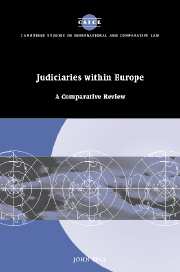Book contents
- Frontmatter
- Contents
- Preface
- List of abbreviations
- 1 Introduction
- 2 The French judiciary
- 3 The German judiciary
- 4 The Spanish judiciary
- 5 The Swedish judiciary
- 6 The English judiciary in comparative perspective
- 7 Factors shaping the character of the judiciary
- Index
- CAMBRIDGE STUDIES IN INTERNATIONAL AND COMPARATIVE LAW
2 - The French judiciary
Published online by Cambridge University Press: 21 July 2009
- Frontmatter
- Contents
- Preface
- List of abbreviations
- 1 Introduction
- 2 The French judiciary
- 3 The German judiciary
- 4 The Spanish judiciary
- 5 The Swedish judiciary
- 6 The English judiciary in comparative perspective
- 7 Factors shaping the character of the judiciary
- Index
- CAMBRIDGE STUDIES IN INTERNATIONAL AND COMPARATIVE LAW
Summary
Unlike most European countries, France does not have a single body of professional judges. There are several corps of judges and, as I have argued elsewhere, there are different legal cultures within France. If anything, the distinction of the corps has been accentuated in recent years, although the origins of many differences pre-date the Revolution of 1789. Among the professional judges, there is a major distinction between the magistrats judiciaires, dealing with civil and criminal law, on the one hand, and the two main corps of administrative judges on the other. Both these groups of judges are civil servants and, therefore, there are similarities in the way they are recruited, even if there are also significant differences. To these must be added a body of judges who are not strictly speaking professional judges, the members of the Conseil constitutionnel, who are appointed for a non-renewable period of nine years. There are also several bodies of non-professional judges, each of which has its own particular connections to social communities, as well as to the professional judges. It is not possible to present a picture of ‘the judiciary’ in France, but there is a patchwork of different features relating to the different judiciaries and their contexts.
Organisational structures
This fragmentation of the judiciary is shaped and reinforced by institutional structures. There are distinct hierarchies of courts, distinct management and distinct career structures.
- Type
- Chapter
- Information
- Judiciaries within EuropeA Comparative Review, pp. 44 - 107Publisher: Cambridge University PressPrint publication year: 2006

